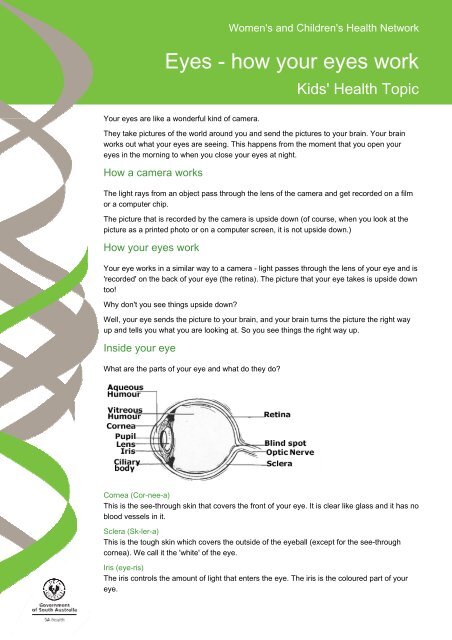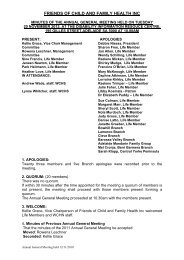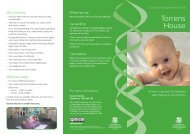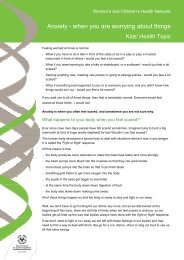Create successful ePaper yourself
Turn your PDF publications into a flip-book with our unique Google optimized e-Paper software.
Women's and Children's Health Net<strong>work</strong><br />
<strong>Eyes</strong> - <strong>how</strong> <strong>your</strong> <strong>eyes</strong> <strong>work</strong><br />
Your <strong>eyes</strong> are like a wonderful kind of camera.<br />
Kids' Health Topic<br />
They take pictures of the world around you and send the pictures to <strong>your</strong> brain. Your brain<br />
<strong>work</strong>s out what <strong>your</strong> <strong>eyes</strong> are seeing. This happens from the moment that you open <strong>your</strong><br />
<strong>eyes</strong> in the morning to when you close <strong>your</strong> <strong>eyes</strong> at night.<br />
How a camera <strong>work</strong>s<br />
The light rays from an object pass through the lens of the camera and get recorded on a film<br />
or a computer chip.<br />
The picture that is recorded by the camera is upside down (of course, when you look at the<br />
picture as a printed photo or on a computer screen, it is not upside down.)<br />
How <strong>your</strong> <strong>eyes</strong> <strong>work</strong><br />
Your eye <strong>work</strong>s in a similar way to a camera - light passes through the lens of <strong>your</strong> eye and is<br />
'recorded' on the back of <strong>your</strong> eye (the retina). The picture that <strong>your</strong> eye takes is upside down<br />
too!<br />
Why don't you see things upside down?<br />
Well, <strong>your</strong> eye sends the picture to <strong>your</strong> brain, and <strong>your</strong> brain turns the picture the right way<br />
up and tells you what you are looking at. So you see things the right way up.<br />
Inside <strong>your</strong> eye<br />
What are the parts of <strong>your</strong> eye and what do they do?<br />
Cornea (Cor-nee-a)<br />
This is the see-through skin that covers the front of <strong>your</strong> eye. It is clear like glass and it has no<br />
blood vessels in it.<br />
Sclera (Sk-ler-a)<br />
This is the tough skin which covers the outside of the eyeball (except for the see-through<br />
cornea). We call it the 'white' of the eye.<br />
Iris (eye-ris)<br />
The iris controls the amount of light that enters the eye. The iris is the coloured part of <strong>your</strong><br />
eye.
Pupil (pew-pil)<br />
This is the hole in the coloured iris. It lets light into <strong>your</strong> eye. It gets very small in bright light,<br />
and bigger in dull light.<br />
The lens<br />
The lens focuses light onto the retina. It changes shape to make sure that the 'picture' on the<br />
retina is as clear as possible.<br />
Retina (Ret-in-a)<br />
This is like a movie screen which s<strong>how</strong>s the picture you are seeing - upside down,<br />
remember? The retina has two lots of cells called 'rods' and 'cones' (because that is what they<br />
look like.) Rods can 'see' black and white. Cones can 'see' colours. They turn the picture into<br />
an electrical message for the brain. Sometimes people don't see all the colours - look at our<br />
topic 'Colour blindness' to find out more.<br />
Blind spot<br />
This is a bit of <strong>your</strong> retina which is not sensitive to light because there are no rods or cones<br />
there. It is the spot where the optic nerve is joined on to the retina.<br />
Optic nerve (op-tic)<br />
The electrical messages from the retina travel along the optic nerve to <strong>your</strong> brain. It's a bit like<br />
the cable that carries all the TV pictures from <strong>your</strong> aerial to <strong>your</strong> TV so that you can see the<br />
programs. The great thing is that our <strong>eyes</strong> take these 'movies' all the time and we don't need<br />
any film or camera.<br />
Eyelids and Eyelashes<br />
These protect <strong>your</strong> <strong>eyes</strong>. The eyelids can shut out light<br />
so that you can sleep. They will shut very fast if they feel<br />
something that is trying to get into <strong>your</strong> eye.<br />
Eyelashes<br />
Eyelashes are very sensitive, and if they feel dust<br />
coming they trap it as <strong>your</strong> eyelids close.<br />
Eyebrows<br />
Eyebrows also help to keep dust and sweat out of <strong>your</strong> <strong>eyes</strong>.<br />
Tear glands<br />
These are small glands inside <strong>your</strong> upper eye lid. Their job is to make tears to keep the<br />
surface of <strong>your</strong> eyeball clean and moist, and help protect <strong>your</strong> eye from damage.<br />
When you blink, <strong>your</strong> eyelids spread the tears over the surface of the eye. Small things that<br />
are on <strong>your</strong> eye (like specks of dust) wash into the corner of <strong>your</strong> eye next to <strong>your</strong> nose.<br />
Sometimes tears flow over <strong>your</strong> lower eyelid (when you cry, or you have hay fever), but<br />
mostly the tears flow down a tiny tube at the edge of <strong>your</strong> lower eyelid, next to <strong>your</strong> nose. (If<br />
you look very carefully you can see a tiny dot that is the beginning of that tube). This tube<br />
carries the tears to the back of <strong>your</strong> nose (and this is why <strong>your</strong> nose 'runs' when you cry!)<br />
Conjunctiva (con-junk-ty-va)<br />
This is the lining on the inside of <strong>your</strong> eyelid and the outside of the front of <strong>your</strong> eye (except<br />
for the special skin of the cornea). You can see some tiny blood vessels on the conjunctiva<br />
over <strong>your</strong> eye. If <strong>your</strong> <strong>eyes</strong> get sore, these blood vessels get bigger and <strong>your</strong> eye looks red.<br />
There are two lots of fluid in the eye.<br />
_____________________________________________________________________<br />
- 2 -<br />
http://www.kids.cyh.com<br />
Last updated: January 2011
Aqueous humour (ak-we-us)<br />
Aqueous means water, and humour means fluid. This watery stuff fills the front of the eyeball<br />
around the lens.<br />
Vitreous humour (vit-re-us)<br />
This is a thicker jelly-like liquid which fills the larger part of the eyeball and keeps it in shape.<br />
(Vitreous means glassy, because the vitreous humour is very clear, so that light can pass<br />
through it).<br />
Ciliary muscles (sil-e-re)<br />
These are a circle of tiny muscles around the lens. They change the shape of the lens by<br />
squeezing and relaxing. They squeeze (making the lens fat) to look at nearby objects, and<br />
relax (making the lens thinner) for far away objects.<br />
Your <strong>eyes</strong> are very beautiful and also very clever, because all the different parts <strong>work</strong><br />
together to help you see!<br />
Inside a cow's eye<br />
If you ever get a chance to cut up a cow's eye in <strong>your</strong> science or health class, do it! It is very<br />
interesting because it's very like the human eye, and is also very beautiful because there are<br />
lots of beautiful colours inside. This is what you will see:<br />
The retina<br />
The retina lines the inside of the back and sides of the eye. You can see the blind spot on the<br />
inside lining of the eye (there is a little hollow and no blood vessels go over the blind spot).<br />
The lens<br />
This looks like a thick jelly disc. It is made of lots of thin layers of see-through cells (a bit like<br />
all the layers in an onion).<br />
You can hold it in a pair of tweezers and look through it.<br />
If you change the shape by squeezing it, you can see <strong>how</strong> the image changes as you look<br />
through.<br />
The iris<br />
This is the coloured part of the eye. It has muscles that change the size of the pupil to change<br />
the amount of light coming into the eye.<br />
The muscles<br />
You can see these all round the outside of the eyeball, ready to move it in the direction the<br />
cow wanted to look.<br />
It really is interesting! (Well, it may be just a bit yucky too!)<br />
Dr Kate says:<br />
<strong>Eyes</strong> are really amazing. We need to look after them very carefully, because they are so<br />
important.<br />
_____________________________________________________________________<br />
- 3 -<br />
http://www.kids.cyh.com<br />
Last updated: January 2011









